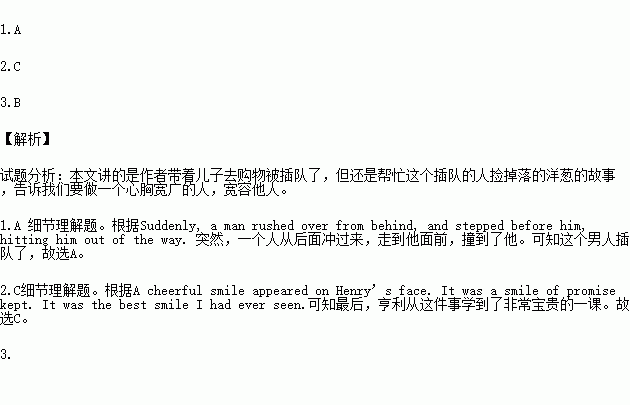题目内容
Weekends are normally a time for shopping and last Saturday was no exception. My son Henry and I were shopping in a neighborhood market. Henry was busy weighing each new bag of vegetables I selected. I gave him a bag of potatoes and he walked over to the scale and waited in line. Suddenly, a man rushed over from behind, and stepped before him, hitting him out of the way. Henry looked shocked and scared. Seeing this I left my shopping cart and walked over to Henry, saying loudly, “Are you OK, honey? I saw what that man did to you. That was very, very wrong.”
When the man finished weighing his bag, his sudden turning around made all his onions fall to the ground. The three of us stood there, frozen for a moment. And then I bent down on my hands and knees and started collecting onions. After I handed the onions to the man, he accepted them and put them into his bag. After Henry and I picked up all the onions, the man walked away without saying anything. We didn’t discuss the event until we got back in the car.
On the way back home, Henry said through tears, “Mommy, I’ve a frustrating day. That man cut right in front of me. And we had to help him pick up his onions! Why did we do that? That didn’t make any sense!”
I took a deep breath and said, “Henry, that man seemed to have a very bad mood today. We should forgive him. I was also angry with the man for treating you rudely. I really wanted to kick him. But doing that doesn’t make any sense. If we hadn’t helped him, we might have felt good for a moment, but then I bet we would have felt really sorry for a long time. You and I have a lot of love to share. Maybe that man doesn’t have much. People who behave badly still need love.”
A cheerful smile appeared on Henry’s face. It was a smile of promise kept. It was the best smile I had ever seen. It was a good moment. It may have been my best mommy moment ever.
1.What did the man do?
A. He cut in the line.
B. He hit Henry on the head.
C. He hurried away without paying.
D. He ran into Henry suddenly.
2. What can we infer from the passage?
A. The author was not angry at all with what the man had done.
B. The man was very sorry for what he had done to Henry.
C. At last, Henry learned a very valuable life lesson from the event.
D. Henry didn’t help the author pick up the onions for the man.
3. Which of the following word can best describe the author?
A. Narrow-minded. B. Broad-minded.
C. Strong-willed. D. Bad-tempered.

